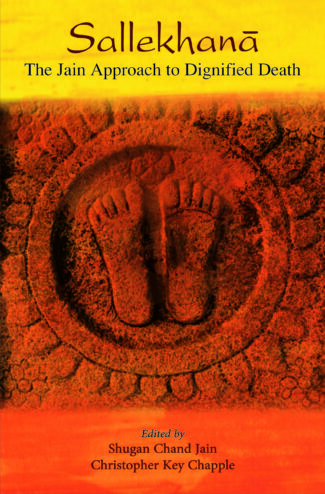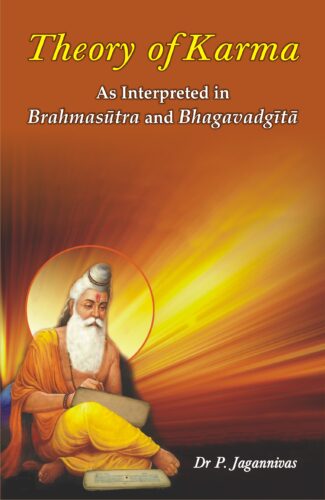-


Sapiens and Sthitapr...
Sapiens and Sthitaprajna
A Comparative Study in Seneca’s Stoicism and the Bhagavadgita by: Ashwini A. Mokashi₹720.00
ISBN: 9788124609637
Year Of Publication: 2019
Edition: 1st Edition
Pages : xxxiii, 187
Bibliographic Details : Bibliography; Index
Language : English
Binding : Hardcover
Publisher: D.K. Printworld Pvt. Ltd.
Size: 23
Weight: 550
Sapiens and Sthitaprajna studies the concept of a wise person in the Stoic Seneca and in the Bhagavadgita. Although the Gita and Seneca’s writings were composed at least two centuries apart and a continent apart, they have much in common in recommending a well-lived life. This book describes how in both a wise person is endowed with both virtue and wisdom, is moral, makes right judgements and takes responsibility for actions. A wise and virtuous person always enjoys happiness, as happiness consists in knowing that one has done the right thing at the right time.
Both Seneca and the Gita demand intellectual rigour and wisdom for leading a virtuous and effective life. They provide guidelines for how to become and be wise. Both systems demand a sage to be emotionally sound and devoid of passions. This leads to mental peace and balance, and ultimately tranquillity and happiness. While surveying these similarities, this study also finds differences in their ways of application of these ideas. The metaphysics of the Gita obliges the sage to practise meditation, while the Stoics require a sage to be a rational person committed to analysing and intellectualizing any situation.
This comparative study will be of interest to students of both Ancient Western and Ancient Indian Philosophy. Practitioners of Stoicism and followers of the Gita should find the presence of closely-related ideas in a very different tradition of interest while perhaps finding somewhat different prescriptions a spur to action.
Foreword – Sharad Deshpande
Prologue – Shivaji Sondhi
Preface
Acknowledgements
- Introduction
Comparative Philosophy
Plan of Action
Chapter Layout
Stoicism
Introduction to the Bhagavadgita
- Seneca’s Sapiens
Background of the Concept
Who is a Sapiens?
Characteristics of a Sapiens
Ethics in Action
Significance for Contemporary Life
How Does one Become a Sapiens?
Stoic Ethics: Focus on Virtue
Oi’ keiosis
Detachment: Trait of Character
Theory of Indifferents
Different Aspects of Wisdom
Stoic Dialectics : Theory of Assent
Laws of Nature (Telos)
Theory of Impulse
Life of Contemplation and Philosophic Leisure
Seneca’s Treatment of Emotions
Discourse on Anger
Causes of Anger
Futility of Anger
Utility of Anger
Treatment of Anger
Discourse on Grief
Being in Pain is Unnatural
Cure for Grief
Discourse on Death
Pythian Oracle: “Know Thyself!”
Living Life to the Fullest
Culmination of Stoic Ethics into Happiness
Harmony in Thought and Action
Seneca on Tranquillity
Virtue is the Foundation for Happiness
Pleasure vs Happiness
Philosophical Critique and Reflections
Indifference to Wealth and Accumulation of Wealth
Seneca’s Own Wealth Questioned
Pitfalls of the Concept of the Sapiens: Utopian and Elitist
On Theories Regarding Emotions
Emotions Confused with Passions Simultaneously Denied
Contradictory Views on Anger
Platonic Idealism Reflected in Stoicism
- Sthitaprajna : The Sage of the Gita
Introduction
Description of Sthitaprajna
Various Terms Denoting the Sage: Sthitaprajna
State of Wisdom
Genesis of the Concept in the Upanishads
Process of Becoming a Sthitaprajna
Simile of a Chariot from the Upanishads
Abandonment of Desires
Power of Mind
Resolute Buddhi
Discipline of Senses
Moksha (End Goal)
Brahman
Sadhana: Pathway and Prerequisites of Meditation
Samadhi
Karma-Yoga and Jnana-Yoga
Svadharma and Paradharma
No Conflict between Karma-Yoga and Jnana-Yoga
Sthitaprajna: An Expert in Karma-Yoga and Jnana-Yoga
Acquisition of Virtue
Equanimity as a Virtue
Tranquillity as a Virtue
Non-Attachment as a Virtue
Promise of True Happiness
Shanti, Nirvana and Brahmi-sthiti
Philosophical Critique and Reflections
Morality of Right Action
Gita’s Perspective on the External World: Two Objections
Destruction of Intelligence because of Failure to Abide by Yoga
Renunciation Rejected by the Gita
Concern for Oneself and Concern for the Other
Is Happiness a Feeling?
- Philosophical Comparison between Seneca and the Gita
Introduction
Social Background
Structure of Society and Description of Era
A Way of Life
Concepts Embedded in Broader Culture/Literature
Points of Agreement
Virtue
Wisdom
Understanding Psychology
Points of Disagreement
Metaphysical Differences
Conceptual Differences
Differences in Ethical Concepts
Difference in Processes of Becoming a Wise Person
Morality Combined with the Notion of Right Action
Seneca’s Treatment/Therapy of Emotions
Conclusion
- Conclusion
Epilogue
Bibliography
Index
Sapiens and Sthitaprajna: A Comparative Study in Seneca’s Stoicism and the Bhagavadgita (hereafter Gita), by Ashwini Mokashi is an important addition to the growing list of publications of comparative ethics based on ancient wisdom texts. In contrasting Seneca’s writings with the text of the Gita, Mokashi makes an important contribution to the field of developing ethics in a global context. Such a dialogue can elucidate overlapping virtues despite great cultural and geographic variation showing that people from dissimilar cultures, follow a different ordering of values rather than hold differing values (1). In the Gita section of the Hindu epic, Mahabharata, two factions of the same family face off with one another on the battlefield with time on “pause,” while the epic’s protagonist the warrior and great archer Arjuna, has an existential crisis. He confides his fears to his charioteer, Krishna, that he knows by day’s end all the casualties will be that of his kin. Unbeknownst to Arjuna, Krishna, is actually the avatar of the Hindu God Vishnu, who walks Arjuna through the nature of life disciplines of knowledge, action and devotion that are not always fixed entities, but require, at times, expanding and re-ordering. The Sthitaprajna is the practitioner who has succeeded in conquering the “inner battlefield” of the warring self to reach a selfhood of moral clarity that is reflected in his actions conducted with equanimity and non-attachment. Sapere (v.), although negatively inserted into the Enlightenment war cry, to this day it remains anchored in Greek, Jewish, Christian thought as the thread linking successive sources of Europe’s spiritual tradition of being “wise” or “knowing.” Morality was preserved in the lives of a Sapiens who singularly could make a great difference to the world by exercising his moral power so much so that the wise person becomes unconquerable in the world in understanding the laws of nature and following the Stoic ethical principles [p. 57]. Sapiens and Sthitaprajna advances the conversation with the classics at a time of waning general humanities curriculum. As, W. T. De Bary, author of The Great Civilized Conversation wrote, no other approach than studying the classics and the perennial questions will give us a clearer sense of direction for value judgments that have been informed by the experience of the best minds of the past and the best way to do this is to have engaged them in conversation (2).
(1) Rosemont Jr., Henry. (2015). Against Individualism: A Confucian Rethinking of the Foundations of Morality, Politics, Family, and Religion. Lexington Books. London. Pg. 21
(2) http://www.neh.gov/about/awards/national-humanities-medals/william-theodore-de-bary
Book Review in Prabuddha Bharata, March 2021, Vol. 125, No. 3
D.K Printworld Ltd.,‘Vedasri’, F-395, Sudarshan Park, New Delhi 110015. Website: https://www.dkprintworld.com. 2019. 215 pp. Rs 800. HB. ISBN 9788124609637.
Seneca and the gita recognize the virtues of detachment. They both see the attitude of detachment as a positive phenomenon and distinguish it from its negative sibling of indifference. Detachment is not a way to turn a blind eye to unpleasant facts. Rather it is a way to dissosiate oneself from one’s surroundings to continue doing one’s work. It defines our attitude in the wake of difficulties, accepting that all of us have problems of some kind or the other at various stages. It is possible to incorporate one’s miseries in one’s life by being detached about them and continue with one’s agenda. Detachment is required not only in times of great emotional upheavals, but also in times of great joy. Either extreme of pleasure or pain takes its toll on human mind and clouds one’s judgement about right or wrong. It also takes one away from the goal, making it twice as difficult to return to the path of virtue. Hence detachment becomes crucial in the pursuit of virtue and right action.
Stoics counsel people to be neither bothered by pain, nor be infatuated by pleasure, but to maintain one’s emotional equilibrium. Stoics deny passion, but do not nullify the capacity for action. In Seneca’s view, what inhibits people from becoming wise is their inclination to emotional disorder. Once a man has the right disposition, it enables him to become wise. Seneca cites an example of the Sapiens, who neither reacts with anger, nor with indifference to the murder of his father, yet avenges the wrong. Seneca would not allow an individual to be vindictive, driven by passion, grief or anger, but rather by his sense of duty and righteousness. Seneca refers to the Stoic doctrine of ‘indifferents’, where Stoics lay out a plan about what aspects of life are indifferent to one’s goal in life and how even conventionally important things, such as health and wealth, are also indifferent to one’s essential living.
The Gita views the basic barrier as one’s inclination to desires. Detachment leads to the path of knowledge. Freedom from desires leads to stability of intelligence and peace of mind. Combining the above factors with the study of yoga leads one to the path of being a sthitaprajna. This stage also helps one develop freedom from attachment and relish a perfectly poised discernment. The Gita asserts that the difference between the wise and the ignorant man is that of having and not having a sense of detachment.









There are no reviews yet.